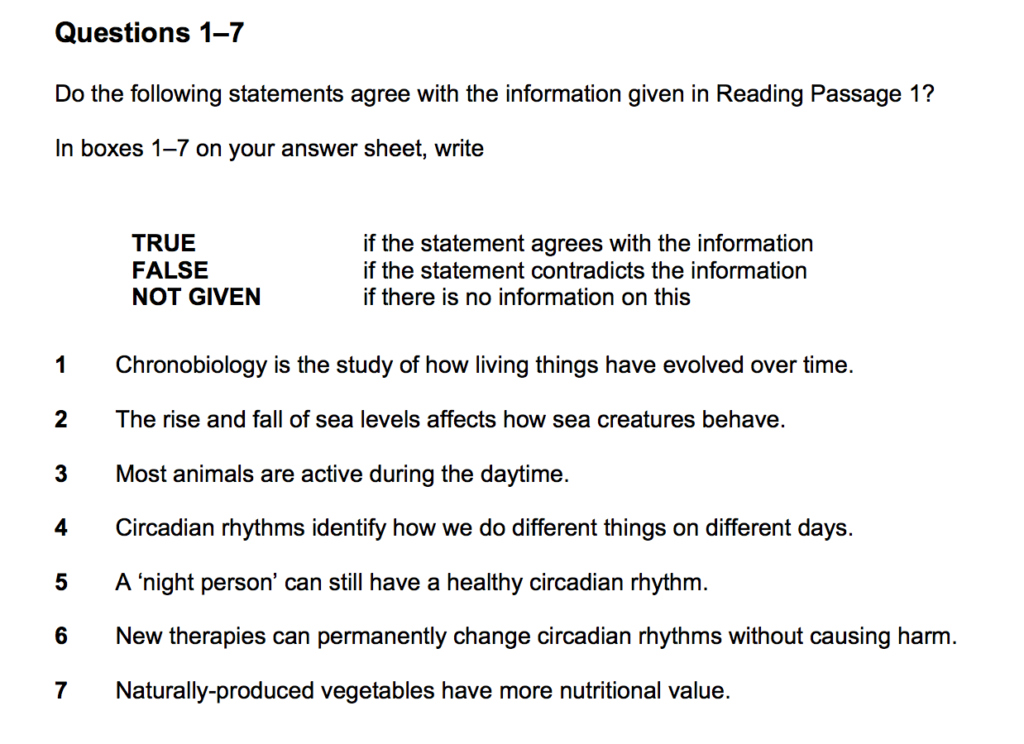The IELTS Reading Module has 40 questions that come in a variety of formats. As the reading section can include between 1500 to 2500 words, learning techniques on how to answer each of these question types quickly will help ensure that you get top marks in this module. Keep reading for more and review your Magoosh IELTS prep to practice refining these skills!
In previous posts, we looked at how to answer sentence completion questions and matching headings questions. Today, we are going to find out how to answer true/false/not given questions.

True/False/Not Given Question Format
The screenshot below is an example of a true/false/not given question from the British Council’s Academic Reading Practice Test 1.
These questions are stated as a list of facts. You have to look at the text and decide if the facts are true, false or not given. Simply put:
- If the fact that you are given matches the reading, then it is TRUE.
- If the fact that you are given contradicts the information in the reading in some way, then it is FALSE.
- If the fact that you are given is not mentioned in the reading, then it is NOT GIVEN.

Answering Techniques
- The questions generally follow the order of the text. So start with question 1. Read the fact slowly to make sure that you fully understand what it says.
Example: Read question 1. Question 1) Chronobiology is the study of how living things have evolved over time.
- Then turn the statement into a question.
Example: Is chronobiology the study of how living things have evolved over time?
- Next, use your scanning and skimming skills to find the information in the reading passage.
Example: In this reading passage, I scanned for the noun chronobiology and found this text: “Chronobiology might sound a little futuristic – like something from a science fiction novel, perhaps – but it’s actually a field of study that concerns one of the oldest processes life on this planet has ever known: short-term rhythms of time and their effect on flora and fauna.”
- When you think you have found the answer, read the text carefully to determine if you think it is true/false/or not given. If the answer to the question you formed is ‘yes’, then it is true. If your answer is ‘no’, then it is false. If you can’t answer the question, then the answer is not given.
Example: The reading passage uses the words ‘short-term rhythms of time’, whilst the question fact says ‘how living things have evolved over time’. Evolving ‘over-time’ refers to something that happens long-term. So this fact is FALSE.
- Questions will probably use synonyms rather than the words in the text.
Example: Question 2 states the fact: “The rise and fall of sea levels affects how sea creatures behave.” The reading passage says: “Marine life, for example, is influenced by tidal patterns.” Sea creatures is used instead of marine life. Also, the rise and fall of sea levels is used instead of tidal patterns. So this fact is TRUE.
- Look out for words that qualify the sentence or make the sentence restrictive in some way, for example adjectives like ‘only’, ‘little’, ‘all’, ‘some’, ‘always’, ‘never’, ‘sometimes’ etc., as some questions will alter just that one word in the statement.
Example: Question 4) states the fact. ‘Circadian rhythms identify how we do different things on different days.’ The reading passage says: ‘When it comes to humans, chronobiologists are interested in what is known as the circadian rhythm. This is the complete cycle our bodies are naturally geared to undergo within the passage of a twenty-four hour day.” Here different days and twenty-four hour days become qualify statements. We can easily see that this fact then is FALSE.
- If you find you are spending a long time looking for the answer to one question, then probably the information is not given, and that will be your answer.
Example: Question 3 states the fact: ‘Most animals are active during the daytime.’ The reading passage says: ‘Animals tend to be active or inactive depending on the position of the sun or moon. Numerous creatures, humans included, are largely diurnal – that is, they like to come out during the hours of sunlight. Nocturnal animals, such as bats and possums, prefer to forage by night. A third group are known as crepuscular: they thrive in the low-light of dawn and dusk and remain inactive at other hours.’ Although the passage talks about when animals are active, it does not mention when most animals are active. So this answer is NOT GIVEN.
Hopefully now that you know how some of the questions are stated and the techniques that you can use to find the right answer, you will whizz through the Reading Module.
The “Other” Not-Given Question Type
A final word: be aware that IELTS Reading also features Yes/No/Not Given questions. These are subtly different from True/False/Not Given. To understand the small but important differences, read our tutorial on IELTS Reading Yes/No/Not Given questions for comparison.
And if you want to learn about all of the IELTS Reading question types, read Magoosh’s full IELTS Reading question types article.






Leave a Reply